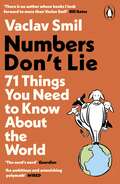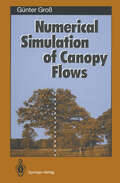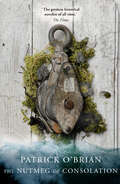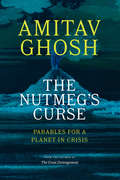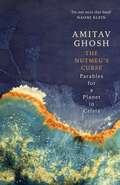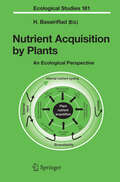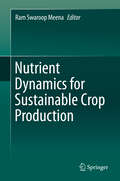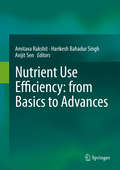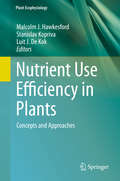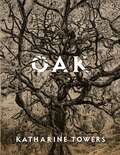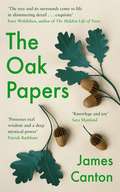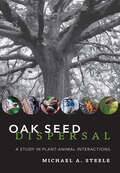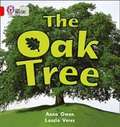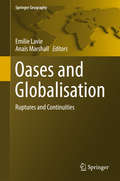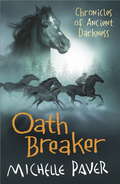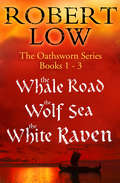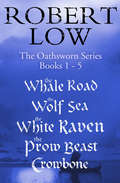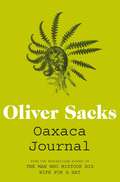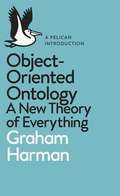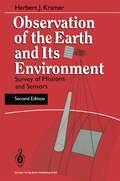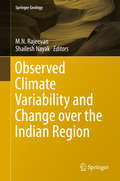- Table View
- List View
Numbers Don't Lie: 71 Things You Need to Know About the World
by Vaclav Smil'There is no author whose books I look forward to more than Vaclav Smil' Bill GatesIs flying dangerous? How much do the world's cows weigh? And what makes people happy?From earth's nations and inhabitants, through the fuels and foods that energize them, to the transportation and inventions of our modern world - and how all of this affects the planet itself - in Numbers Don't Lie, Professor Vaclav Smil takes us on a fact-finding adventure, using surprising statistics and illuminating graphs to challenge lazy thinking.Packed with 'Well-I-never-knew-that' information and with fascinating and unusual examples throughout, we find out how many people it took to build the Great Pyramid, that vaccination yields the best return on investment, and why electric cars aren't as great as we think (yet). There's a wonderful mix of science, history and wit, all in bite-sized chapters on a broad range of topics.Urgent and essential, Numbers Don't Lie inspires readers to interrogate what they take to be true in these significant times. Smil is on a mission to make facts matter, because after all, numbers may not lie, but which truth do they convey?'He is rigorously numeric, using data to illuminate every topic he writes about. The word "polymath" was invented to describe people like him' Bill Gates 'Important' Mark Zuckerberg, on Energy 'One of the world's foremost thinkers on development history and a master of statistical analysis . . . The nerd's nerd' Guardian 'There is perhaps no other academic who paints pictures with numbers like Smil' Guardian 'In a world of specialized intellectuals, Smil is an ambitious and astonishing polymath who swings for fences . . . They're among the most data-heavy books you'll find, with a remarkable way of framing basic facts' Wired 'Vaclav Smil has led a 30-year career of interdisciplinary contrarianism, writing hundreds of scientific articles and dozens of books attacking sacred cows of Western environmental and geopolitical thought' Foreign Policy 'For a couple of decades, Vaclav Smil has been on my go-to list when questions arise about global trends and risks, and particularly about energy. He is a distinguished professor on the environment faculty at the University of Manitoba but really should be in the department of everything' Andrew Revkin, The New York Times 'One of the world's foremost experts on energy' Foreign Affairs 'An author who does not allow facts to be obscured or overshadowed by politics' New York Review of Books 'The man who has quietly shaped how the world thinks about energy' Science Magazine 'A radical thinker on energy and environmental issues' Financial Times 'He's a slayer of bullshit' David Keith, Gordon McKay Professor of Applied Physics & Professor of Public Policy, Harvard UniversityVaclav Smil is Distinguished Professor Emeritus at the University of Manitoba. He is the author of over forty books on topics including energy, environmental and population change, food production and nutrition, technical innovation, risk assessment and public policy. No other living scientist has had more books (on a wide variety of topics) reviewed in Nature. A Fellow of the Royal Society of Canada, in 2010 he was named by Foreign Policy as one of the Top 100 Global Thinkers. This is his first book for a more general readership.
Numerical Simulation of Canopy Flows (Springer Series in Physical Environment #12)
by Günter GroßStarting with the description of meteorological variables in forest canopies and its parameter variations, a numerical three-dimentional model is developed. Its applicability is demonstrated, first, by wind sheltering effects of hedges and, second, by the effects of deforestation on local climate in complex terrain. Scientists in ecology, agricultural botany and meteorology, but also urban and regional lanners will profit from this study finding the most effective solution for their specific problems.
The Nutmeg of Consolation: Aubrey/maturin Series, Book 14 (Aubrey/Maturin Series #14)
by Patrick O’BrianPatrick O’Brian’s Aubrey-Maturin tales are widely acknowledged to be the greatest series of historical novels ever written. Now, for the first time, they are available in electronic book format, so a whole new generation of readers can be swept away on the adventure of a lifetime. This is the fourteenth book in the series.
The Nutmeg's Curse: Parables for a Planet in Crisis
by Amitav GhoshIn this ambitious successor to The Great Derangement, acclaimed writer Amitav Ghosh finds the origins of our contemporary climate crisis in Western colonialism’s violent exploitation of human life and the natural environment. A powerful work of history, essay, testimony, and polemic, Amitav Ghosh’s new book traces our contemporary planetary crisis back to the discovery of the New World and the sea route to the Indian Ocean. The Nutmeg’s Curse argues that the dynamics of climate change today are rooted in a centuries-old geopolitical order constructed by Western colonialism. At the center of Ghosh’s narrative is the now-ubiquitous spice nutmeg. The history of the nutmeg is one of conquest and exploitation—of both human life and the natural environment. In Ghosh’s hands, the story of the nutmeg becomes a parable for our environmental crisis, revealing the ways human history has always been entangled with earthly materials such as spices, tea, sugarcane, opium, and fossil fuels. Our crisis, he shows, is ultimately the result of a mechanistic view of the earth, where nature exists only as a resource for humans to use for our own ends, rather than a force of its own, full of agency and meaning. Writing against the backdrop of the global pandemic and the Black Lives Matter protests, Ghosh frames these historical stories in a way that connects our shared colonial histories with the deep inequality we see around us today. By interweaving discussions on everything from the global history of the oil trade to the migrant crisis and the animist spirituality of Indigenous communities around the world, The Nutmeg’s Curse offers a sharp critique of Western society and speaks to the profoundly remarkable ways in which human history is shaped by non-human forces.
The Nutmeg's Curse: Parables for a Planet in Crisis
by Amitav Ghosh'Do not miss this book' NAOMI KLEIN, author of This Changes EverythingThe history of the nutmeg is one of conquest and exploitation - of both human life and the natural environment - and the origin of our contemporary climate crisis.Tracing the threats to our future to the discovery of the New World and the sea route to the Indian Ocean, The Nutmeg's Curse argues that the dynamics of climate change are rooted in a centuries-old geopolitical order constructed by Western colonialism. The story of the nutmeg becomes a parable revealing the ways human history has always been entangled with earthly materials - spices, tea, sugarcane, opium, and fossil fuels. Our crisis, Ghosh shows, is ultimately the result of a mechanistic view of the earth, where nature exists only as a resource for humans to use for our own ends, rather than a force of its own, full of agency and meaning.Writing against the backdrop of the global pandemic and the Black Lives Matter protests, Ghosh frames these historical stories in a way that connects our shared colonial past with the deep inequality we see around us today. By interweaving discussions on everything from the global history of the oil trade to the migrant crisis and the animist spirituality of indigenous communities around the world, The Nutmeg's Curse offers a sharp critique of contemporary society and speaks to the profoundly remarkable ways in which human history is shaped by non-human forces.
Nutrient Acquisition by Plants: An Ecological Perspective (Ecological Studies #181)
by Hormoz BassiriRadThis is an integrated review of the mechanisms controlling plant nutrient uptake and how plants respond to changes in the environment. Among key topics covered are: soil nutrient bioavailability; root responses to variations in nutrient supply; nitrogen fixation; root architecture; life span; mycorrhizae; responses to climate change. The book helps us understand the mechanisms that govern present-day plant communities and to predict the response of plants to a changing climate.
Nutrient Dynamics for Sustainable Crop Production
by Ram Swaroop MeenaThe cropping system is one of the important components of sustainable agriculture, since it provides more efficient nutrient cycling. As such, balanced fertilization must be based on the concept of sustainable crop production. Feeding the rapidly growing world population using environmentally sustainable production systems is a major challenge, especially in developing countries. A number of studies have highlighted the fact that degradation of the world's cultivated soils is largely responsible for low and plateauing yields. Soil is lost rapidly but only formed over millennia, and this represents the greatest global threat to nutrient dynamics in agriculture. This means that nutrient management is essential to provide food and nutritional security for current and future generations. Nutrient dynamics and soil sustainability imply the maintenance of the desired ecological balance, the enhancement and preservation of soil functions, and the protection of biodiversity above and below ground. Understanding the role of nutrient management as a tool for soil sustainability and nutritional security requires a holistic approach to a wide range of soil parameters (biological, physical, and chemical) to assess the soil functions and nutrient dynamics of a crop management system within the desired timescale. Further, best nutrient management approaches are important to advance soil sustainability and food and nutritional security without compromising the soil quality and productive potential. Sustainable management practices must allow environmentally and economically sustainable yields and restore soil health and sustainability. This book presents soil management approaches that can provide a wide range of benefits, including improved fertility, with a focus on the importance of nutrient dynamics. Discussing the broad impacts of nutrients cycling on the sustainability of soil and the cropping systems that it supports, it also addresses nutrient application to allow environmentally and economically sustainable agroecosystems that restore soil health. Arguing that balanced fertilization must be based on the concept of INM for a cropping system rather than a crop, it provides a roadmap to nutrient management for sustainability. This richly illustrated book features tables, figures and photographs and includes extensive up-to-date references, making it a valuable resource for policymakers and researchers, as well as undergraduate and graduate students of Soil Science, Agronomy, Ecology and Environmental Sciences.
Nutrient Use Efficiency: From Basics To Advances
by Amitava Rakshit Harikesh Bahadur Singh Avijit SenThis book addresses in detail multifaceted approaches to boosting nutrient use efficiency (NUE) that are modified by plant interactions with environmental variables and combine physiological, microbial, biotechnological and agronomic aspects. Conveying an in-depth understanding of the topic will spark the development of new cultivars and strains to induce NUE, coupled with best management practices that will immensely benefit agricultural systems, safeguarding their soil, water, and air quality. Written by recognized experts in the field, the book is intended to provide students, scientists and policymakers with essential insights into holistic approaches to NUE, as well as an overview of some successful case studies. In the present understanding of agriculture, NUE represents a question of process optimization in response to the increasing fragility of our natural resources base and threats to food grain security across the globe. Further improving nutrient use efficiency is a prerequisite to reducing production costs, expanding crop acreage into non-competitive marginal lands with low nutrient resources, and preventing environmental contamination. The nutrients most commonly limiting plant growth are N, P, K, S and micronutrients like Fe, Zn, B and Mo. NUE depends on the ability to efficiently take up the nutrient from the soil, but also on transport, storage, mobilization, usage within the plant and the environment. A number of approaches can help us to understand NUE as a whole. One involves adopting best crop management practices that take into account root-induced rhizosphere processes, which play a pivotal role in controlling nutrient dynamics in the soil-plant-atmosphere continuum. New technologies, from basic tools like leaf color charts to sophisticated sensor-based systems and laser land leveling, can reduce the dependency on laboratory assistance and manual labor. Another approach concerns the development of crop plants through genetic manipulations that allow them to take up and assimilate nutrients more efficiently, as well as identifying processes of plant responses to nutrient deficiency stress and exploring natural genetic variation. Though only recently introduced, the ability of microbial inoculants to induce NUE is gaining in importance, as the loss, immobilization, release and availability of nutrients are mediated by soil microbial processes.
Nutrient Use Efficiency in Plants: Concepts and Approaches (Plant Ecophysiology #10)
by Malcolm J. Hawkesford Stanislav Kopriva Luit J. De KokNutrient Use Efficiency in Plants: Concepts and Approaches is the ninth volume in the Plant Ecophysiology series. It presents a broad overview of topics related to improvement of nutrient use efficiency of crops. Nutrient use efficiency (NUE) is a measure of how well plants use the available mineral nutrients. It can be defined as yield (biomass) per unit input (fertilizer, nutrient content). NUE is a complex trait: it depends on the ability to take up the nutrients from the soil, but also on transport, storage, mobilization, usage within the plant, and even on the environment. NUE is of particular interest as a major target for crop improvement. Improvement of NUE is an essential pre-requisite for expansion of crop production into marginal lands with low nutrient availability but also a way to reduce use of inorganic fertilizer.
Oak
by Katharine TowersOak is terrifically imaginative look at the life-cycle of the oak, from acorn to mighty, its place in the forest ecosystem, the home it provides for other animals, the role, both practical and mythical, that it plays in the human realm. It is a remarkable window into the slow journey of a different kind of consciousness and being, one we rarely see depicted in this way.
The Oak Papers
by James Canton'A profound meditation on the human need for connection with nature' Peter Wohlleben This is a book about one man’s encounter with an ancient tree, the Honywood Oak. James Canton spent two years sitting with and studying the Honywood Oak. A colossus of a tree, it would have been a sapling when the Magna Carta was signed. Inevitably he needs to slow down in order to appreciate it fully, to tune in to its slower time frame, to connect with the ecosystem that lives around it, inside it and beneath it. He examines our long-standing dependency on oak trees, and how that has developed and morphed into myth and legend. We no longer build our houses and boats from them, use them to fuel our fires or grind their acorns into flour in times of famine; physically we don’t need them in the same way now. Or do we? The Oak Papers is a stunning, meditative and healing book about the lessons we can learn from the natural world, if only we slow down enough to listen.
Oak Seed Dispersal: A Study in Plant-Animal Interactions
by Michael A. SteeleSeed dispersal is a critical stage in the life cycle of most flowering plants. The process can have far-reaching effects on a species' biology, especially numerous aspects of its ecology and evolution. This is particularly the case for the oaks, in which the dispersal of the acorn is tied to numerous tree characteristics, as well as the behavior and ecology of the animals that feed on and move these seeds to their final destination. Forest structure, composition, and genetics often follow directly from the dispersal process—while also influencing it in turn. In Oak Seed Dispersal, Michael A. Steele draws on three decades of field research across the globe (e.g., the United States, Mexico, Central America, Europe, and China) to describe the interactions between oaks and their seed consumers. Rodents, birds, and insects, he writes, collectively influence the survival, movement, and germination of acorns, as well as the establishment of seedlings, often indicating a coevolutionary bond between oaks and their seed consumers. This bond can only be understood by unraveling the complex interactions that occur in the context of factors such as partial seed consumption due to acorn chemistry, scatterhoarding, predation of the seed consumers by other organisms, and the limiting effects of masting on insect, rodent, and jay damage.Offering new insights on how animal-mediated dispersal drives ecological and evolutionary processes in forest ecosystems, Oak Seed Dispersal also includes an overview of threatened oak forests across the globe and explains how a lack of acorn dispersal contributes to many important conservation challenges. Highly illustrated, the book includes photographs of key dispersal organisms and tactics, as well as a foreword by Stephen B. Vander Wall, a leading authority on food hoarding and animal-mediated seed dispersal, and beautiful artwork by Tad C. Theimer, also an accomplished ecologist.
Oak Seed Dispersal: A Study in Plant-Animal Interactions
by Michael A. SteeleSeed dispersal is a critical stage in the life cycle of most flowering plants. The process can have far-reaching effects on a species' biology, especially numerous aspects of its ecology and evolution. This is particularly the case for the oaks, in which the dispersal of the acorn is tied to numerous tree characteristics, as well as the behavior and ecology of the animals that feed on and move these seeds to their final destination. Forest structure, composition, and genetics often follow directly from the dispersal process—while also influencing it in turn. In Oak Seed Dispersal, Michael A. Steele draws on three decades of field research across the globe (e.g., the United States, Mexico, Central America, Europe, and China) to describe the interactions between oaks and their seed consumers. Rodents, birds, and insects, he writes, collectively influence the survival, movement, and germination of acorns, as well as the establishment of seedlings, often indicating a coevolutionary bond between oaks and their seed consumers. This bond can only be understood by unraveling the complex interactions that occur in the context of factors such as partial seed consumption due to acorn chemistry, scatterhoarding, predation of the seed consumers by other organisms, and the limiting effects of masting on insect, rodent, and jay damage.Offering new insights on how animal-mediated dispersal drives ecological and evolutionary processes in forest ecosystems, Oak Seed Dispersal also includes an overview of threatened oak forests across the globe and explains how a lack of acorn dispersal contributes to many important conservation challenges. Highly illustrated, the book includes photographs of key dispersal organisms and tactics, as well as a foreword by Stephen B. Vander Wall, a leading authority on food hoarding and animal-mediated seed dispersal, and beautiful artwork by Tad C. Theimer, also an accomplished ecologist.
The Oak Tree: Band 02b/Red B (PDF)
by Anna Owen Cliff Moon Laszlo Veres Collins Big CatA non-fiction, photographic picture book about the different parts of an oak tree and the creatures that live in its roots, trunk, bark, branches and leaves. The photographs and life-like illustrations answer the repeated question: 'Who lives…?'
Oak tree (Large Print)
by Rnib BookshareIn this image of an oak tree, the trunk stems from the bottom centre of the page and the leafy branches are in the middle of the page. There is a locator dot shown, which will be at the top left of the page when the image is the right way up. There is a picture of an oak leaf in the top left and a picture of an acorn in the top right of the page. The leaf stem is to the top right of the leaf itself. The nut is similarly positioned. For scale there is a 'stick man' representing the height of an adult person in the bottom right of the page. The oak tree provided the strong wood necessary for building the ships of the British Royal Navy when it comprised square rigged sailing ships. The oak can live to be up to 600 years old and even after dying the main trunk (called a monolith) can stand for another 60 years before finally falling.
Oak tree (UEB Contracted)
by Rnib BookshareIn this image of an oak tree, the trunk stems from the bottom centre of the page and the leafy branches are in the middle of the page. There is a locator dot shown, which will be at the top left of the page when the image is the right way up. There is a picture of an oak leaf in the top left and a picture of an acorn in the top right of the page. The leaf stem is to the top right of the leaf itself. The nut is similarly positioned. For scale there is a 'stick man' representing the height of an adult person in the bottom right of the page. The oak tree provided the strong wood necessary for building the ships of the British Royal Navy when it comprised square rigged sailing ships. The oak can live to be up to 600 years old and even after dying the main trunk (called a monolith) can stand for another 60 years before finally falling.
Oak tree (UEB Uncontracted)
by Rnib BookshareIn this image of an oak tree, the trunk stems from the bottom centre of the page and the leafy branches are in the middle of the page. There is a locator dot shown, which will be at the top left of the page when the image is the right way up. There is a picture of an oak leaf in the top left and a picture of an acorn in the top right of the page. The leaf stem is to the top right of the leaf itself. The nut is similarly positioned. For scale there is a 'stick man' representing the height of an adult person in the bottom right of the page. The oak tree provided the strong wood necessary for building the ships of the British Royal Navy when it comprised square rigged sailing ships. The oak can live to be up to 600 years old and even after dying the main trunk (called a monolith) can stand for another 60 years before finally falling.
Oases and Globalization: Ruptures and Continuities (Springer Geography)
by Emilie Lavie Anaïs MarshallThis book is a reference work about the study of oases in the context of globalization. It is based on selected papers presented at the international colloquium entitled Oases in the Globalization, Ruptures and Continuities in Paris (December 16-17th, 2013). The main issue was to understand how oases have been excluded from or included into the process of globalization.In this context, the present book proposes firstly a discussion about the definition(s) of oasis and secondly several case studies analysing socio-spatial mutations in the oasis structure. The third part deals with the compelling globalization at different spatial scales, using two entries: the water management and local impacts of external control.
Oath Breaker: Book 5 (Chronicles of Ancient Darkness #No. 5)
by Michelle PaverWhen he was outcast, Torak was the hunted one. The following spring, he becomes the hunter when he swears to avenge the killing of one of his closest friends. To fulfil his oath he must brave the hidden valleys of the Deep Forest, where the clans have reverted to the savagery of an earlier time. Here, Torak finally learns why he is the Sprit Walker and discovers the true cost of revenge.Launched at the height of the Harry Potter phenomenon, the Chronicles of Ancient Darkness is the ultimate magical adventure. This edition contains brand new interviews with Michelle Paver. Audio edition also available, read by Ian McKellen.
The Oathsworn Series Books 1 to 3
by Robert LowThe band of Viking brothers, The Oathsworn, are here. These are the first 3 epic novels in Robert Low’s brilliant Oathsworn series.
The Oathsworn Series Books 1 to 5
by Robert LowThe band of Viking brothers, The Oathsworn, are here. These are the first 5 epic novels in Robert Low’s brilliant Oathsworn series.
Oaxaca Journal (National Geographic Directions Ser.)
by Oliver Sacks‘Light and fast-moving, unburdened by library research but filled with erudition’ New Yorker Oliver Sacks, the bestselling author of Awakenings and The Man Who Mistook His Wife for a Hat, is most famous for his studies of the human mind: insightful and beautifully characterized portraits of those experiencing complex neurological conditions. However, he has another scientific passion: the fern. Since childhood Oliver has been fascinated by the ability of these primitive plants to survive and adapt in many climates. Oaxaca Journal is the enthralling account of his trip, alongside a group of fellow fern enthusiasts, to the beautiful province of Oaxaca, Mexico. Bringing together Oliver’s endless curiosity about natural history and the richness of human culture with his sharp eye for detail, this book is a captivating evocation of a place, its plants, its people, and its myriad wonders.
Object-Oriented Ontology: A New Theory of Everything
by Graham HarmanWhat is reality, really?Are humans more special or important than the non-human objects we perceive?How does this change the way we understand the world?We humans tend to believe that things are only real in as much as we perceive them, an idea reinforced by modern philosophy, which privileges us as special, radically different in kind from all other objects. But as Graham Harman, one of the theory's leading exponents, shows, Object-Oriented Ontology rejects the idea of human specialness: the world, he states, is clearly not the world as manifest to humans. At the heart of this philosophy is the idea that objects - whether real, fictional, natural, artificial, human or non-human - are mutually autonomous. In this brilliant new introduction, Graham Harman lays out the history, ideas and impact of Object-Oriented Ontology, taking in everything from art and literature, politics and natural science along the way.Graham Harman is Distinguished Professor of Philosophy at SCI-Arc, Los Angeles. A key figure in the contemporary speculative realism movement in philosophy and for his development of the field of object-oriented ontology, he was named by Art Review magazine as one of the 100 most influential figures in international art.
Observation of the Earth and its Environment: Survey of Missions and Sensors
by Herbert J. KramerThe following listing represents a survey and a short description of 'Earth Observing Mis sions' in alphabetical order. The listing in Part A considers completed-, operational-as well as planned missions on an international scale (Earth observations from space know no na tional boundaries). A look into past activities is important for reasons of heritage, context and of perspective. The document is intended for all who want to keep track of missions and sensors in the fast -growing field of Earth observations. There cannot be any claim to com pleteness, although a considerable effort was made to collect and integrate all known mis sions and sensors into this book. Earth observation by remote sensing changes our view and perception of the world. We be gin to realize the global character of remote sensing, its multidimensional and complemen tary nature, its vast potential to many disciplines, its importance to mankind as a whole. Re mote sensing permits for the first time in history a total system view of the Earth. The view from space toward Earth has brought about sweeping revisions in the Earth sciences, in par ticular in such fields as meteorology, oceanology, hydrology, geology, geography, forestry, agriculture, geodynamics, solar-terrestrial interactions, and many others.
Observed Climate Variability and Change over the Indian Region (Springer Geology)
by M. N. Rajeevan Shailesh NayakThe objective of the book is to make a comprehensive documentation of the observed variability and change of the regional climate system over the Indian region using the past observed data. The book addresses all the important parameters of regional climate system so that a physically consistent view of the changes of the climate system is documented. The book contains 16 chapters written by the subject experts from different academic and research institutes in India. The book addresses all important components/parameters of the climate system, like rainfall, temperature, humidity, clouds, moisture, sea surface temperature and ocean heat content, sea level, glaciers and snow cover, tropical cyclones and monsoon depressions, extreme rainfall and rainstorms, heat waves and cold waves, meteorological droughts, aerosols, atmospheric aerosols, ozone and trace gases and atmospheric radiative fluxes. One chapter deals with the past monsoon using monsoon proxy data. The last chapter deals with the future climate change projections over the Indian region (rainfall and temperature) made using coupled climate models. Most of the analyses (especially on rainfall, temperature, extreme rainfall, sea surface temperature, meteorological droughts) are based on the data for a longer period of 110 years, 1901–2010. For some other parameters like moisture, clouds, heat waves and cold waves, atmospheric aerosols, ozone and trace gases and radiative fluxes, data of shorter period have been used. The articles documented inter-annual and decadal variability in addition to documenting long term trends of different parameters. The trends have been tested for statistical significance using standard techniques. It is expected that the present book will be an excellent reference material for researchers as well as for policy makers. These results will be useful in interpreting future climate change scenarios over the region being projected using coupled climate models. Further analysis of these results is required for attributing the observed variability and change to natural and anthropogenic activities.
